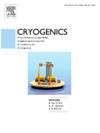Experiment performance study of a single-stage coaxial pulse tube cryocooler pre-cooled by liquid nitrogen operating at 56 Hz: Achieving 0.5 [email protected] K cooling capacity
IF 2.1
3区 工程技术
Q3 PHYSICS, APPLIED
引用次数: 0
Abstract
The increasing demand for lightweight, high efficiency cooling systems in space cryogenic detection necessitates advancements in pulse tube cryocooler (PTC) design. Traditional two-stage PTCs precool the second-stage hot end to 80 K using the first stage, but the second-stage compressor operates at ambient temperature, inducing significant thermal losses in the transition regenerator due to temperature gradients. This inefficiency, coupled with low operating frequencies and high mass/volume limitations, impedes performance. This study proposes a new single-stage high frequency PTC system to replace traditional second-stage units, addressing compactness and efficiency challenges. The system employs liquid nitrogen precooling (total mass: 2.6 kg) and integrates an inertance tube-gas reservoir phase shifter with a stainless steel screen regenerator. A multi-physics coupling model optimizes phase modulation, enabling direct cooling in the 80 K range. At 1 MPa and 56 Hz with 10 W input power, the system achieves a no-load temperature of 15.8 K after precooling. Operational testing demonstrates 0.5 W effective cooling capacity at 25.5 K and a specific mass cooling power of 192 mW/kg. Frequency optimization reveals enhanced performance near 60 Hz, achieving a record low no-load temperature of 13.5 K at 62 Hz and effective cooling within the 20 K range. Further integration with a micro compressor (300 g, 30 W) is proposed, leveraging first-stage PTC precooling to minimize system volume and mass. This design advances high frequency PTC technology for space applications, offering superior cooling density and operational flexibility compared to traditional architectures.
56 Hz液氮预冷单级同轴脉冲管制冷机的实验性能研究:达到0.5 K制冷量
在空间低温探测中,对轻量化、高效率冷却系统的需求日益增长,这就要求脉冲管制冷机(PTC)的设计取得进步。传统的两级ptc使用第一级将第二级热端预冷至80k,但第二级压缩机在环境温度下运行,由于温度梯度,在过渡再生器中会产生显着的热损失。这种低效率,加上低工作频率和高质量/体积限制,阻碍了性能。本研究提出了一种新的单级高频PTC系统来取代传统的二级装置,解决了紧凑性和效率方面的挑战。该系统采用液氮预冷(总质量:2.6 kg),集成了一个惰性管-储气相移器和一个不锈钢筛网再生器。多物理场耦合模型优化了相位调制,实现了80 K范围内的直接冷却。在1mpa、56hz、10w输入功率下,预冷后系统空载温度为15.8 K。运行测试表明,25.5 K时的有效冷却能力为0.5 W,比质量冷却功率为192 mW/kg。频率优化显示了在60 Hz附近的性能增强,在62 Hz时实现了创纪录的低13.5 K空载温度,在20 K范围内实现了有效冷却。进一步集成微型压缩机(300克,30瓦),利用第一级PTC预冷,以尽量减少系统的体积和质量。该设计将高频PTC技术应用于空间应用,与传统架构相比,提供卓越的冷却密度和操作灵活性。
本文章由计算机程序翻译,如有差异,请以英文原文为准。
求助全文
约1分钟内获得全文
求助全文
来源期刊

Cryogenics
物理-热力学
CiteScore
3.80
自引率
9.50%
发文量
0
审稿时长
2.1 months
期刊介绍:
Cryogenics is the world''s leading journal focusing on all aspects of cryoengineering and cryogenics. Papers published in Cryogenics cover a wide variety of subjects in low temperature engineering and research. Among the areas covered are:
- Applications of superconductivity: magnets, electronics, devices
- Superconductors and their properties
- Properties of materials: metals, alloys, composites, polymers, insulations
- New applications of cryogenic technology to processes, devices, machinery
- Refrigeration and liquefaction technology
- Thermodynamics
- Fluid properties and fluid mechanics
- Heat transfer
- Thermometry and measurement science
- Cryogenics in medicine
- Cryoelectronics
 求助内容:
求助内容: 应助结果提醒方式:
应助结果提醒方式:


